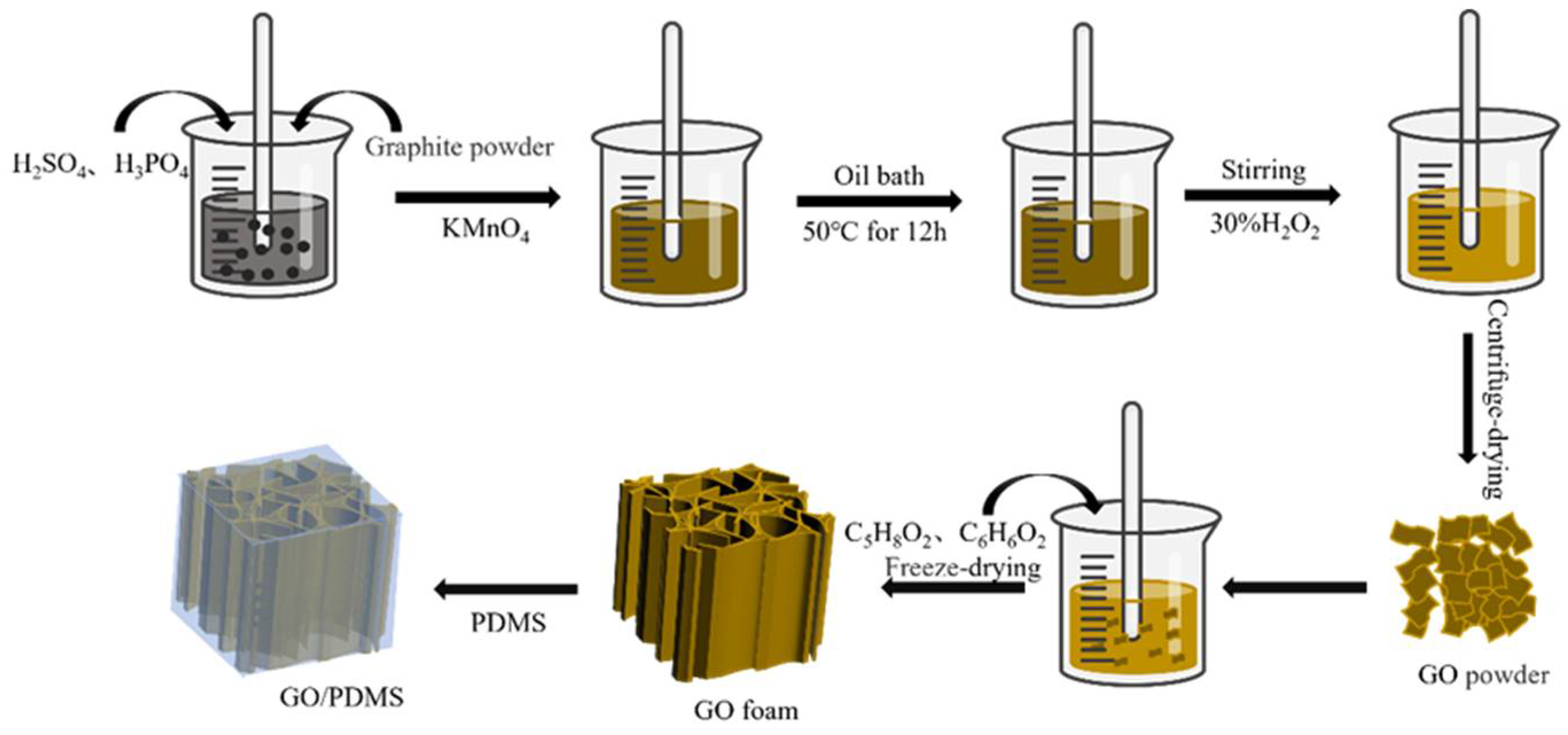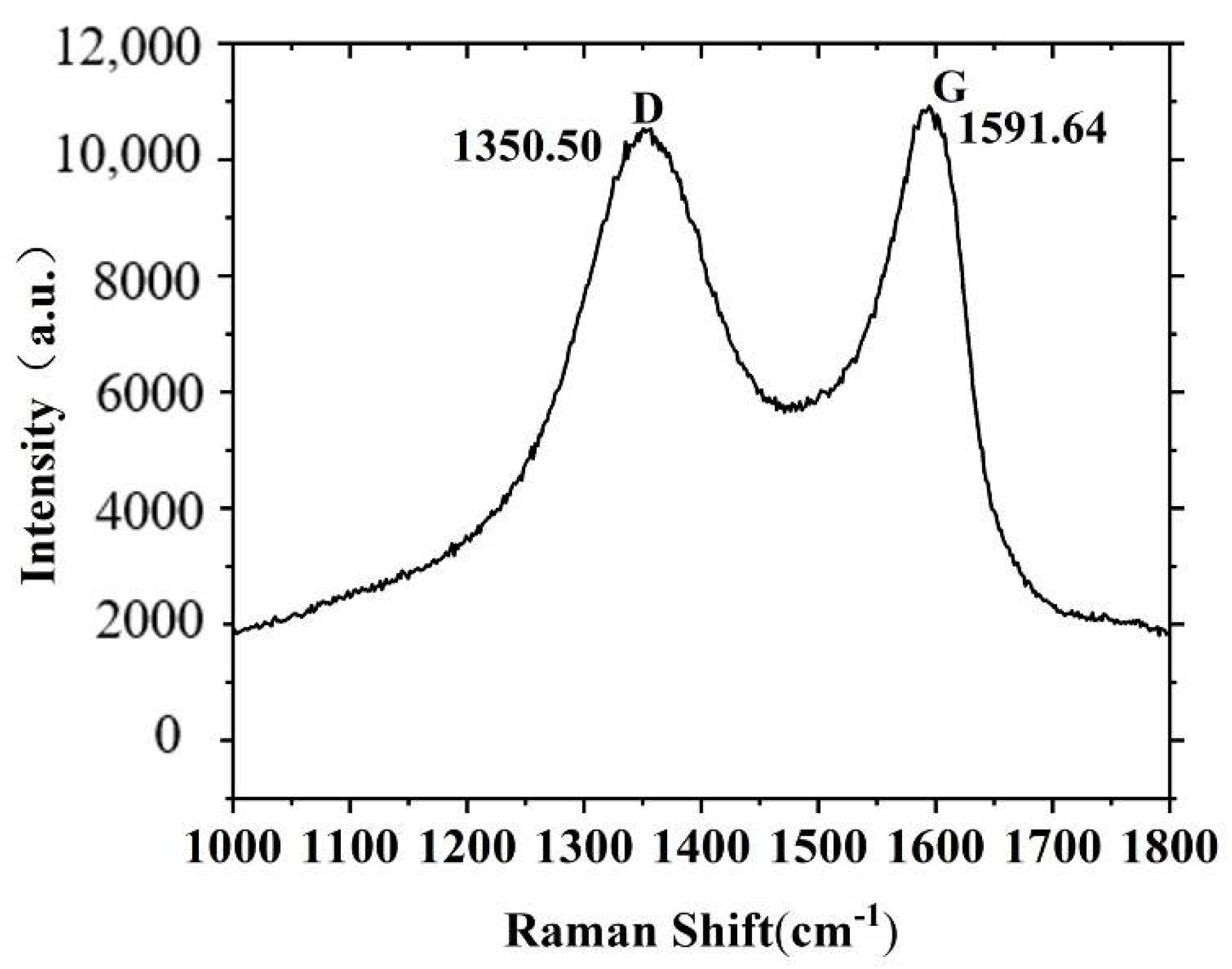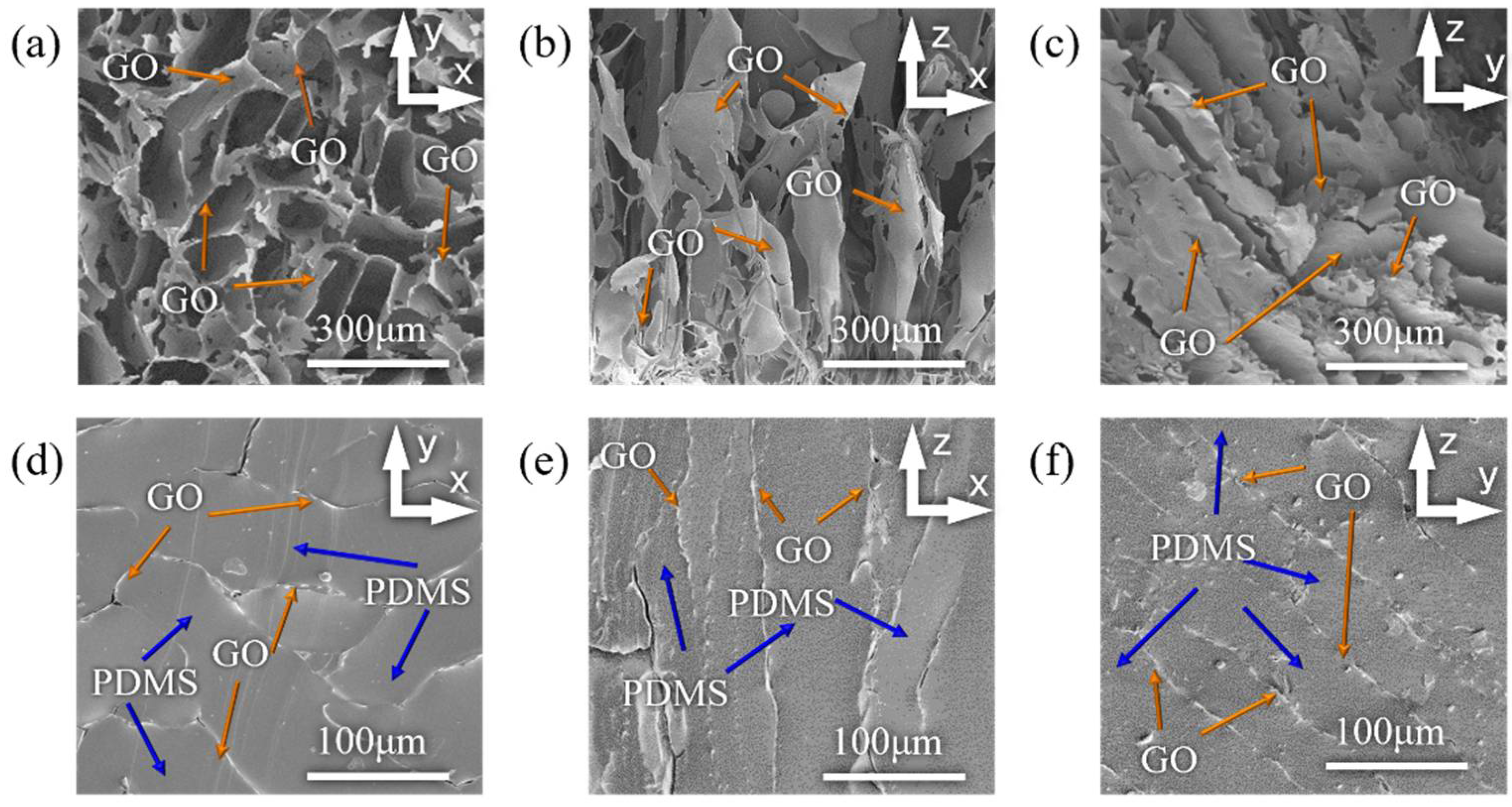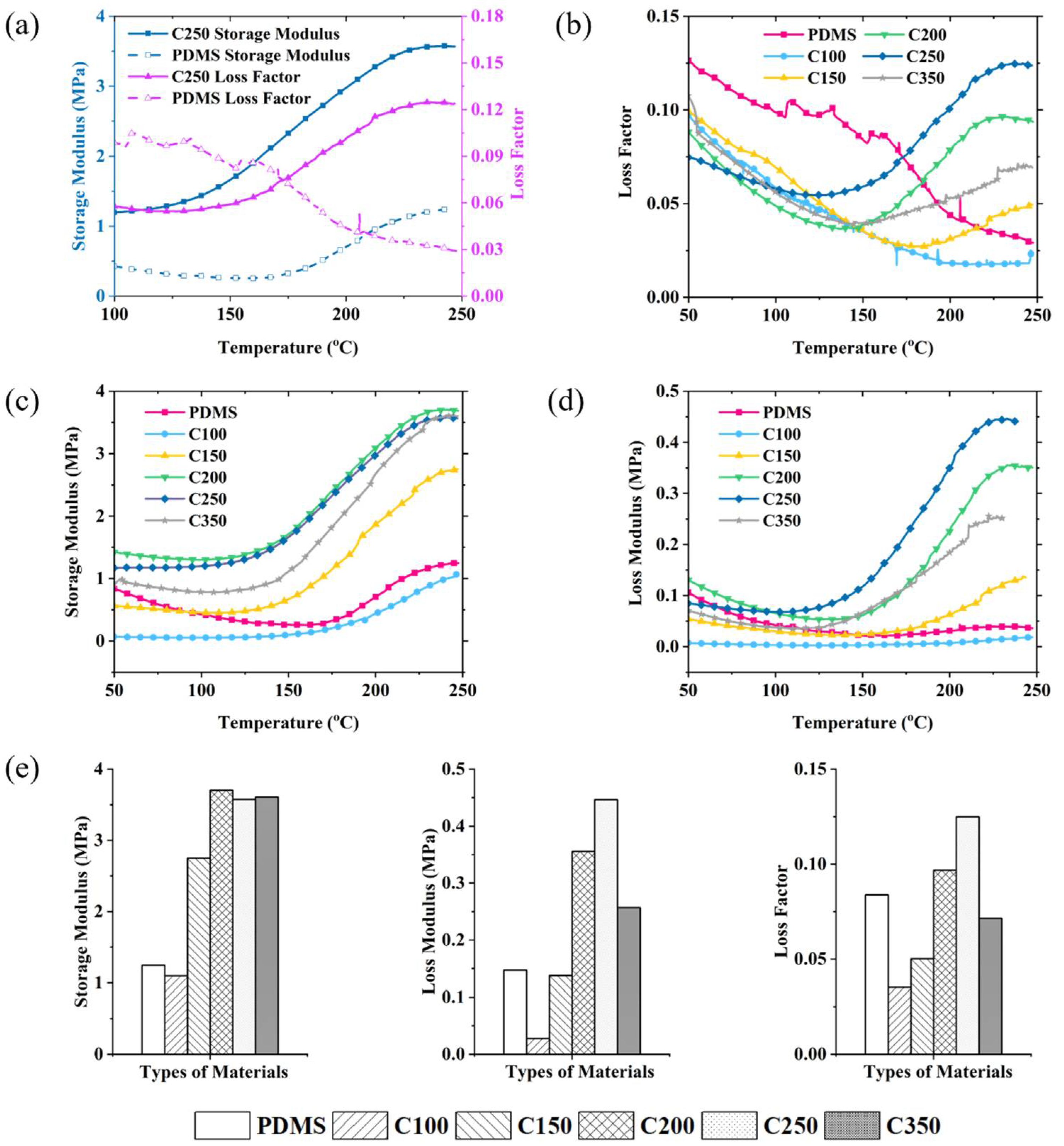Lightweight and Flexible Graphene Foam Composite with Improved Damping Properties
Abstract
:1. Introduction
2. Materials and Methods
2.1. Preparation of Graphene Oxide
2.2. Preparation of GO Foam
2.3. Preparation of GO/PDMS Composite
2.4. GO Characterization
2.5. SEM Characterization
2.6. DMA Characterization
3. Results and Discussion
3.1. Morphology of GO/PDMS
3.2. Dynamic Mechanical Properties of GO/PDMS
4. Conclusions
Author Contributions
Funding
Institutional Review Board Statement
Informed Consent Statement
Data Availability Statement
Conflicts of Interest
References
- Balaji, P.S.; Karthik SelvaKumar, K. Applications of Nonlinearity in Passive Vibration Control: A Review. J. Vib. Eng. Technol. 2021, 9, 183–213. [Google Scholar] [CrossRef]
- Chinke, S.L.; Sandhu, I.S.; Saroha, D.R.; Alegaonkar, P.S. Graphene-Like Nanoflakes for Shock Absorption Applications. ACS Appl. Nano Mater. 2018, 1, 6027–6037. [Google Scholar] [CrossRef]
- Lee, D.-O.; Han, J.-H. A Comparison of Vibration Isolation Characteristics of Various Forms of Passive Vibration Isolator. Trans. Korean Soc. Noise Vib. Eng. 2012, 22, 817–824. [Google Scholar] [CrossRef] [Green Version]
- Han, C.; Kim, B.-G.; Choi, S.-B. Design of a New Magnetorheological Damper Based on Passive Oleo-Pneumatic Landing Gear. J. Aircr. 2018, 55, 2510–2520. [Google Scholar] [CrossRef]
- Ali, A.; Zhang, C.; Bibi, T.; Zhu, L.; Cao, L.; Li, C.; Hsiao, P.-C. Investigation of five different low-cost locally available isolation layer materials used in sliding base isolation systems. Soil Dyn. Earthq. Eng. 2022, 154, 107127. [Google Scholar] [CrossRef]
- Nobari Azar, F.A.; Karimzadeh Naghshineh, A.; Sen, M. Preparation and characterization of natural rubber–based new elastomers for high-damping base isolation systems. J. Elastomers Plast. 2022. [Google Scholar] [CrossRef]
- Liu, M.; Chen, C.; Hu, J.; Wu, X.; Wang, X. Synthesis of Magnetite/Graphene Oxide Composite and Application for Cobalt(II) Removal. J. Phys. Chem. C 2011, 115, 25234–25240. [Google Scholar] [CrossRef]
- Fang, H.; Zhao, Y.; Zhang, Y.; Ren, Y.; Bai, S.L. Three-Dimensional Graphene Foam-Filled Elastomer Composites with High Thermal and Mechanical Properties. ACS Appl. Mater Interfaces 2017, 9, 26447–26459. [Google Scholar] [CrossRef]
- Liu, Q.; Zhou, X.; Fan, X.; Zhu, C.; Yao, X.; Liu, Z. Mechanical and Thermal Properties of Epoxy Resin Nanocomposites Reinforced with Graphene Oxide. Polym.-Plast. Technol. Eng. 2012, 51, 251–256. [Google Scholar] [CrossRef]
- Olowojoba, G.B.; Eslava, S.; Gutierrez, E.S.; Kinloch, A.J.; Mattevi, C.; Rocha, V.G.; Taylor, A.C. In situ thermally reduced graphene oxide/epoxy composites: Thermal and mechanical properties. Appl. Nanosci. 2016, 6, 1015–1022. [Google Scholar] [CrossRef]
- Zhao, W.; Li, T.; Li, Y.; O’Brien, D.J.; Terrones, M.; Wei, B.; Suhr, J.; Lucas Lu, X. Mechanical properties of nanocomposites reinforced by carbon nanotube sponges. J. Mater. 2018, 4, 157–164. [Google Scholar] [CrossRef]
- Ray, S. Chapter 2. Application and Uses of Graphene Oxide and Reduced Graphene Oxide; 2015; pp. 39–55. [Google Scholar] [CrossRef]
- Perrozzi, F.; Prezioso, S.; Ottaviano, L. Graphene oxide: From fundamentals to applications. J. Phys. Condens. Matter 2014, 27, 013002. [Google Scholar] [CrossRef] [PubMed] [Green Version]
- Balandin, A.A.; Ghosh, S.; Bao, W.; Calizo, I.; Teweldebrhan, D.; Miao, F.; Lau, C.N. Superior Thermal Conductivity of Single-Layer Graphene. Nano Lett. 2008, 8, 902–907. [Google Scholar] [CrossRef] [PubMed]
- Geim, A.K.; Novoselov, K.S. The rise of graphene. Nat. Mater. 2007, 6, 183–191. [Google Scholar] [CrossRef] [PubMed]
- Kim, H.; Macosko, C.W. Processing-property relationships of polycarbonate/graphene composites. Polymer 2009, 50, 3797–3809. [Google Scholar] [CrossRef]
- Potts, J.R.; Dreyer, D.R.; Bielawski, C.W.; Ruoff, R.S. Graphene-based polymer nanocomposites. Polymer 2011, 52, 5–25. [Google Scholar] [CrossRef] [Green Version]
- Ghule, B.G.; Shinde, N.M.; Raut, S.D.; Shaikh, S.F.; Al-Enizi, A.M.; Kim, K.H.; Mane, R.S. Porous metal-graphene oxide nanocomposite sensors with high ammonia detectability. J. Colloid Interface Sci. 2021, 589, 401–410. [Google Scholar] [CrossRef]
- Jyoti, J.; Arya, A.K. EMI shielding and dynamic mechanical analysis of graphene oxide-carbon nanotube-acrylonitrile butadiene styrene hybrid composites. Polym. Test. 2020, 91, 106839. [Google Scholar] [CrossRef]
- Shu, R.; Wu, Y.; Li, W.; Zhang, J.; Liu, Y.; Shi, J.; Zheng, M. Fabrication of ferroferric oxide–carbon/reduced graphene oxide nanocomposites derived from Fe-based metal–organic frameworks for microwave absorption. Compos. Sci. Technol. 2020, 196, 108240. [Google Scholar] [CrossRef]
- Wang, Z.; Zhao, P.; He, D.; Cheng, Y.; Liao, L.; Li, S.; Luo, Y.; Peng, Z.; Li, P. Cerium oxide immobilized reduced graphene oxide hybrids with excellent microwave absorbing performance. Phys. Chem. Chem. Phys. 2018, 20, 14155–14165. [Google Scholar] [CrossRef]
- Zhang, K.; Yuan, X.; Li, D.; Du, J.; Wang, B.; Li, T. Mechanical Properties of Solution-Blended Graphene Nanoplatelets/Polyether-Ether-Ketone Nanocomposites. J. Phys. Chem. B 2021, 125, 10597–10609. [Google Scholar] [CrossRef] [PubMed]
- Huang, G.-S.; Li, Q.; Jiang, L.-X. Structure and damping properties of polydimethylsiloxane and polymethacrylate sequential interpenetrating polymer networks. J. Appl. Polym. Sci. 2002, 85, 545–551. [Google Scholar] [CrossRef]
- Schneider, F.; Draheim, J.; Kamberger, R.; Wallrabe, U. Process and material properties of polydimethylsiloxane (PDMS) for Optical MEMS. Sens. Actuators A Phys. 2009, 151, 95–99. [Google Scholar] [CrossRef]
- Sharma, S.K.; Gaur, H.; Kulkarni, M.; Patil, G.; Bhattacharya, B.; Sharma, A. PZT–PDMS composite for active damping of vibrations. Compos. Sci. Technol. 2013, 77, 42–51. [Google Scholar] [CrossRef]
- Emminger, C.; Çakmak, U.D.; Preuer, R.; Graz, I.; Major, Z. Hyperelastic Material Parameter Determination and Numerical Study of TPU and PDMS Dampers. Materials 2021, 14, 7639. [Google Scholar] [CrossRef]
- Zhang, G.; Zhang, J.; Guo, X.; Zhang, M.; Liu, M.; Qiao, Y.; Zhai, P. Effects of graphene oxide on microstructure and mechanical properties of isotropic polydimethylsiloxane-based magnetorheological elastomers. Rheol. Acta 2022, 61, 215–228. [Google Scholar] [CrossRef]
- Han, J.; Du, G.; Gao, W.; Bai, H. An Anisotropically High Thermal Conductive Boron Nitride/Epoxy Composite Based on Nacre-Mimetic 3D Network. Adv. Funct. Mater. 2019, 29, 1900412. [Google Scholar] [CrossRef]
- Owuor, P.S.; Woellner, C.F.; Li, T.; Vinod, S.; Ozden, S.; Kosolwattana, S.; Bhowmick, S.; Duy, L.X.; Salvatierra, R.V.; Wei, B.; et al. High Toughness in Ultralow Density Graphene Oxide Foam. Adv. Mater. Interfaces 2017, 4, 1700030. [Google Scholar] [CrossRef]
- Min, P.; Li, X.; Liu, P.; Liu, J.; Jia, X.Q.; Li, X.P.; Yu, Z.Z. Rational Design of Soft Yet Elastic Lamellar Graphene Aerogels via Bidirectional Freezing for Ultrasensitive Pressure and Bending Sensors. Adv. Funct. Mater. 2021, 31, 2103703. [Google Scholar] [CrossRef]
- Alkhouzaam, A.; Qiblawey, H.; Khraisheh, M.; Atieh, M.; Al-Ghouti, M. Synthesis of graphene oxides particle of high oxidation degree using a modified Hummers method. Ceram. Int. 2020, 46, 23997–24007. [Google Scholar] [CrossRef]
- Chen, L.; Chai, S.; Liu, K.; Ning, N.; Gao, J.; Liu, Q.; Chen, F.; Fu, Q. Enhanced Epoxy/Silica Composites Mechanical Properties by Introducing Graphene Oxide to the Interface. ACS Appl. Mater. Interfaces 2012, 4, 4398–4404. [Google Scholar] [CrossRef] [PubMed]




| Types of Materials | PDMS | C100 | C150 | C200 | C250 | C350 |
|---|---|---|---|---|---|---|
| Storage Modulus (MPa) | 1.24775 | 1.09806 | 2.75027 | 3.70336 | 3.57718 | 3.60997 |
| Loss Modulus (MPa) | 0.14733 | 0.0277 | 0.13773 | 0.35549 | 0.44676 | 0.25675 |
| Loss Factor | 0.08384 | 0.03521 | 0.05014 | 0.09686 | 0.1249 | 0.0715 |
Publisher’s Note: MDPI stays neutral with regard to jurisdictional claims in published maps and institutional affiliations. |
© 2022 by the authors. Licensee MDPI, Basel, Switzerland. This article is an open access article distributed under the terms and conditions of the Creative Commons Attribution (CC BY) license (https://creativecommons.org/licenses/by/4.0/).
Share and Cite
Li, T.; Du, J.; Xu, M.; Song, Z.; Ren, M. Lightweight and Flexible Graphene Foam Composite with Improved Damping Properties. Nanomaterials 2022, 12, 1260. https://doi.org/10.3390/nano12081260
Li T, Du J, Xu M, Song Z, Ren M. Lightweight and Flexible Graphene Foam Composite with Improved Damping Properties. Nanomaterials. 2022; 12(8):1260. https://doi.org/10.3390/nano12081260
Chicago/Turabian StyleLi, Tong, Juan Du, Mi Xu, Zhuoyu Song, and Mingfa Ren. 2022. "Lightweight and Flexible Graphene Foam Composite with Improved Damping Properties" Nanomaterials 12, no. 8: 1260. https://doi.org/10.3390/nano12081260





